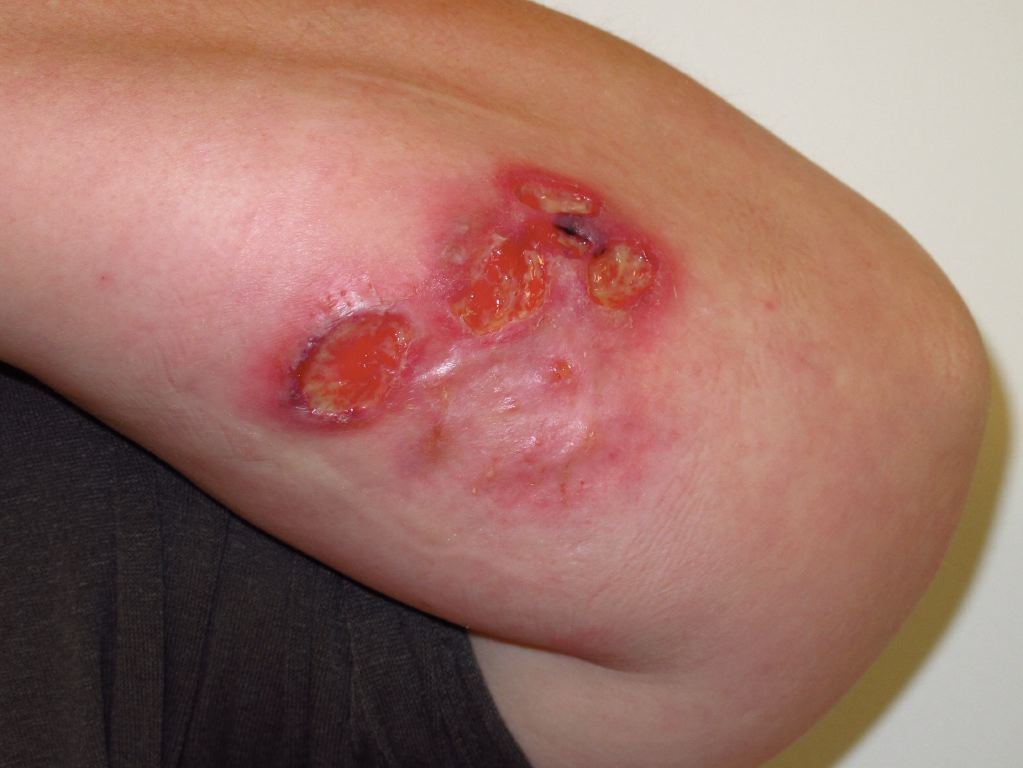[1]
Simpson AM, Chen K, Bohnsack JF, Lamont MN, Siddiqi FA, Gociman B. Pyoderma Gangrenosum-like Wounds in Leukocyte Adhesion Deficiency: Case Report and Review of Literature. Plastic and reconstructive surgery. Global open. 2018 Aug:6(8):e1886. doi: 10.1097/GOX.0000000000001886. Epub 2018 Aug 8
[PubMed PMID: 30254829]
Level 2 (mid-level) evidence
[2]
Abdul-Fattah B, Al-Muriesh M, Huang CZ. Efficacy of topical calcineurin inhibitors in pyoderma gangrenosum. Dermatologic therapy. 2018 Sep:31(5):e12697. doi: 10.1111/dth.12697. Epub 2018 Sep 25
[PubMed PMID: 30252999]
[3]
Skok P, Skok K. Acute febrile neutrophilic dermatosis in a patient with Crohn's disease: case report and review of the literature. Acta dermatovenerologica Alpina, Pannonica, et Adriatica. 2018 Sep:27(3):161-163
[PubMed PMID: 30244270]
Level 3 (low-level) evidence
[4]
Yamamoto T. Epidemiology of pyoderma gangrenosum in Japanese patients by questionnaire survey. The Journal of dermatology. 2019 Apr:46(4):e145-e146. doi: 10.1111/1346-8138.14658. Epub 2018 Sep 19
[PubMed PMID: 30230578]
Level 3 (low-level) evidence
[5]
Brambilla L, Minuti A, Brambilla M, Tourlaki A, Genovese G, Berti E. Late-onset post-mammoplasty pyoderma gangrenosum treated with tobacco-pouch suture combined with oral corticosteroids. Giornale italiano di dermatologia e venereologia : organo ufficiale, Societa italiana di dermatologia e sifilografia. 2020 Oct:155(5):702-704. doi: 10.23736/S0392-0488.18.06123-0. Epub 2018 Sep 18
[PubMed PMID: 30229642]
[6]
Martinez-Rios C, Jariwala MP, Highmore K, Duffy KW, Spiegel L, Laxer RM, Stimec J. Imaging findings of sterile pyogenic arthritis, pyoderma gangrenosum and acne (PAPA) syndrome: differential diagnosis and review of the literature. Pediatric radiology. 2019 Jan:49(1):23-36. doi: 10.1007/s00247-018-4246-1. Epub 2018 Sep 17
[PubMed PMID: 30225645]
[7]
Genovese G, Tavecchio S, Berti E, Rongioletti F, Marzano AV. Pyoderma gangrenosum-like ulcerations in granulomatosis with polyangiitis: two cases and literature review. Rheumatology international. 2018 Jun:38(6):1139-1151. doi: 10.1007/s00296-018-4035-z. Epub 2018 May 2
[PubMed PMID: 29721696]
Level 3 (low-level) evidence
[8]
Lopez Pineiro M, Willis E, Yao C, Chon SY. Pyoderma gangrenosum-like ulceration of the lower extremity secondary to sunitinib therapy: a case report. SAGE open medical case reports. 2018:6():2050313X18783048. doi: 10.1177/2050313X18783048. Epub 2018 Jun 18
[PubMed PMID: 29977559]
Level 3 (low-level) evidence
[9]
Ashchyan HJ, Butler DC, Nelson CA, Noe MH, Tsiaras WG, Lockwood SJ, James WD, Micheletti RG, Rosenbach M, Mostaghimi A. The Association of Age With Clinical Presentation and Comorbidities of Pyoderma Gangrenosum. JAMA dermatology. 2018 Apr 1:154(4):409-413. doi: 10.1001/jamadermatol.2017.5978. Epub
[PubMed PMID: 29450453]
[10]
Vaysse-Vic M, Mathieu PA, Charissoux A, Charissoux JL, Marcheix PS. Pyoderma gangrenosum or necrotising fasciitis? Diagnostic and therapeutic wanderings. Orthopaedics & traumatology, surgery & research : OTSR. 2017 Jun:103(4):615-617. doi: 10.1016/j.otsr.2017.01.009. Epub 2017 Mar 10
[PubMed PMID: 28286096]
[11]
Saffie MG, Shroff A. A Case of Pyoderma Gangrenosum Misdiagnosed as Necrotizing Infection: A Potential Diagnostic Catastrophe. Case reports in infectious diseases. 2018:2018():8907542. doi: 10.1155/2018/8907542. Epub 2018 Apr 26
[PubMed PMID: 29854503]
Level 3 (low-level) evidence
[12]
McKenzie F, Cash D, Gupta A, Cummings LW, Ortega-Loayza AG. Biologic and small-molecule medications in the management of pyoderma gangrenosum. The Journal of dermatological treatment. 2019 May:30(3):264-276. doi: 10.1080/09546634.2018.1506083. Epub 2018 Sep 7
[PubMed PMID: 30051737]
[13]
Bissonnette C, Kauzman A, Mainville GN. Oral Pyoderma Gangrenosum: Diagnosis, Treatment and Challenges: A Systematic Review. Head and neck pathology. 2017 Dec:11(4):427-441. doi: 10.1007/s12105-017-0804-3. Epub 2017 Mar 8
[PubMed PMID: 28275955]
Level 1 (high-level) evidence
[14]
Pichler M, Larcher L, Holzer M, Exler G, Thuile T, Gatscher B, Tappeiner L, Deluca J, Carriere C, Nguyen VA, Moosbrugger-Martinz V, Schmuth M, Klein GF, Eisendle K. Surgical treatment of pyoderma gangrenosum with negative pressure wound therapy and split thickness skin grafting under adequate immunosuppression is a valuable treatment option: Case series of 15 patients. Journal of the American Academy of Dermatology. 2016 Apr:74(4):760-5. doi: 10.1016/j.jaad.2015.09.009. Epub
[PubMed PMID: 26979359]
Level 2 (mid-level) evidence
[15]
Partridge ACR, Bai JW, Rosen CF, Walsh SR, Gulliver WP, Fleming P. Effectiveness of systemic treatments for pyoderma gangrenosum: a systematic review of observational studies and clinical trials. The British journal of dermatology. 2018 Aug:179(2):290-295. doi: 10.1111/bjd.16485. Epub 2018 Jun 6
[PubMed PMID: 29478243]
Level 1 (high-level) evidence
[16]
Kaffenberger BH, Hinton A, Krishna SG. The impact of underlying disease state on outcomes in patients with pyoderma gangrenosum: A national survey. Journal of the American Academy of Dermatology. 2018 Oct:79(4):659-663.e2. doi: 10.1016/j.jaad.2018.02.007. Epub 2018 Feb 10
[PubMed PMID: 29438762]
Level 3 (low-level) evidence

